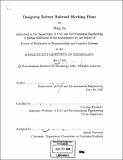Designing robust railroad blocking plans
Author(s)
Jin, Hong, 1968 Jan. 4-
DownloadFull printable version (8.833Mb)
Advisor
Cynthia Barnhart.
Terms of use
Metadata
Show full item recordAbstract
On major domestic railroads, a typical general merchandise shipment, or commodity, may pass through many classification yards on its route from origin to destination. At these yards, the incoming traffic, which may consist of several shipments, is reclassified (sorted and grouped together) to be placed on outgoing trains. On average, each reclassification results in an one day delay for the shipment. In addition, the classification process is labor and capital intensive. To prevent shipments from being reclassified at every yard they pass through, several shipments may be grouped together to form a block. The blocking problem consists of choosing the set of blocks to be built at each terminal (the blocking plan) and assigning each commodity to a series of blocks that will take it from origin to destination. It is one of the most important problems in railroad freight transportation since a good blocking plan can reduce the number of reclassifications of the shipments, thus reducing operating costs and delays associated with excess reclassifications. We provide a variety of model formulations that attain the minimum costs for different problem instances. The deterministic model identifies the blocking plan for the problems with certainty in problem inputs. Static stochastic models provide blocking plans that are feasible for all possible realizations of uncertainties in demand and supply. Dynamic stochastic models generate blocking plans that balance flow costs and plan change costs for possible realizations of uncertainties. We adopt Lagrangian relaxation techniques to decompose the resulting huge mixed integer programming models into two smaller subproblems. This reduces storage requirements and computational efforts to solve these huge problems. We propose other enhancements to reduce computational burden, such as adding a set of valid inequalities and using advanced start dual solutions. These enhancements help tighten the lower bounds and facilitate the generation of high quality feasible solutions. We test the proposed models and solution approaches using the data from a major railroad. Compared to current blocking plans, the solutions from our model reduce the total number of classifications significantly, leading to potential savings of millions of dollars annually. We also investigate various problem aggregation techniques to determine the appropriate ways of generating satisfactory blocking plans with different levels of computational resources. We illustrate the benefits of robust planning by comparing the total costs of our robust plans with those of our deterministic plans. The experiments show that the the realized costs can be reduced by around 50% using robust blocking plans.
Description
Thesis (Ph.D.)--Massachusetts Institute of Technology, Dept. of Civil and Environmental Engineering, 1998. Includes bibliographical references (leaves 121-130).
Date issued
1998Department
Massachusetts Institute of Technology. Department of Civil and Environmental EngineeringPublisher
Massachusetts Institute of Technology
Keywords
Civil and Environmental Engineering